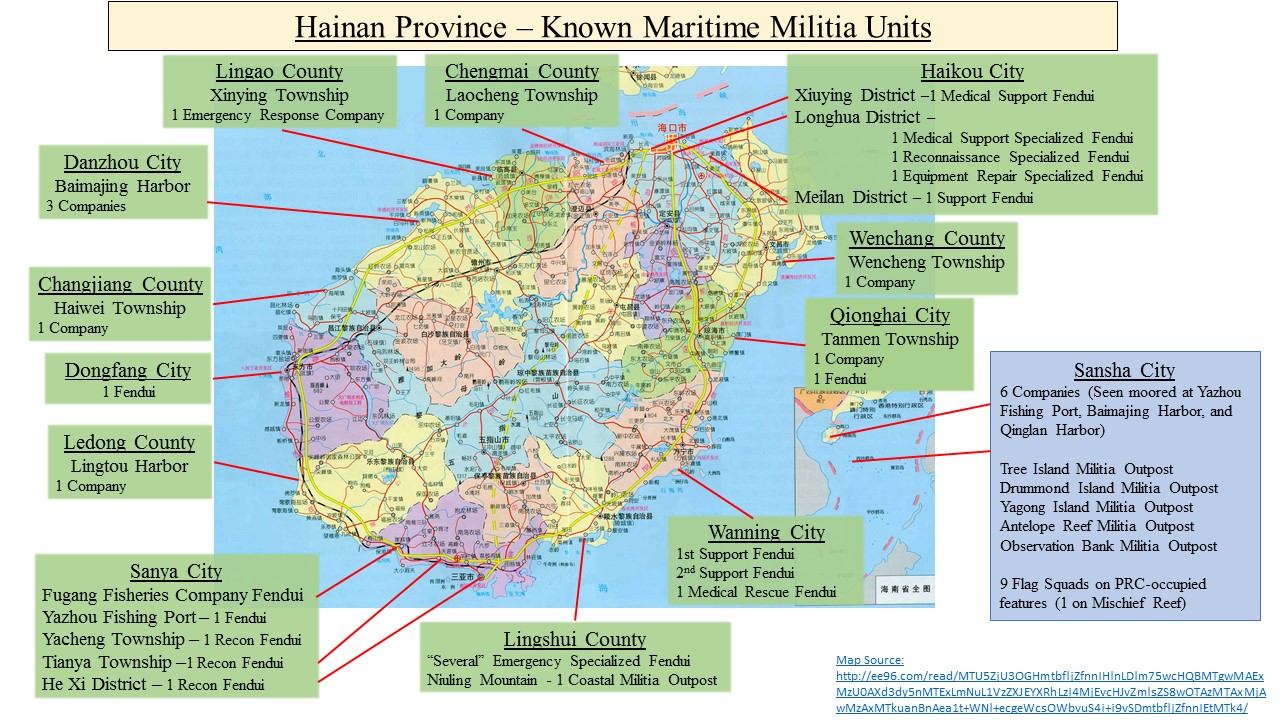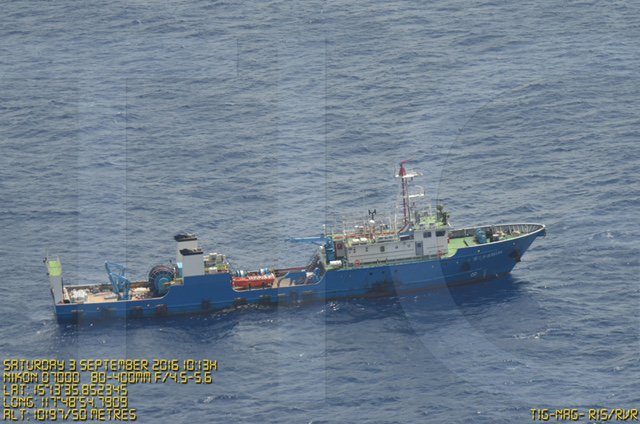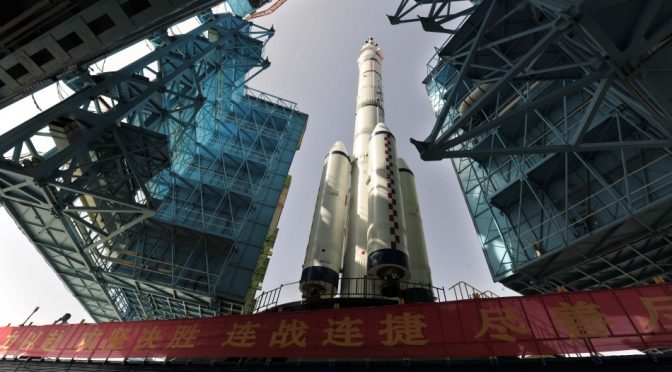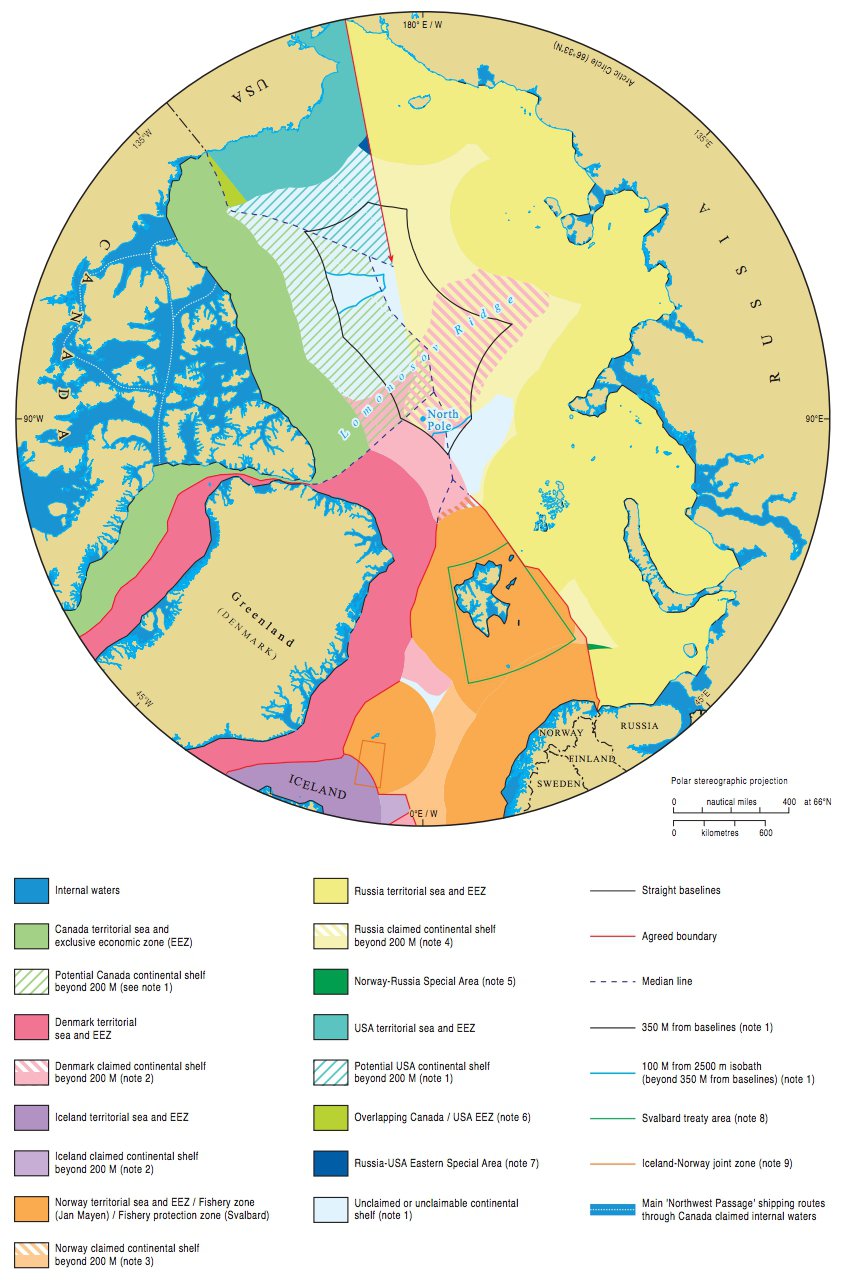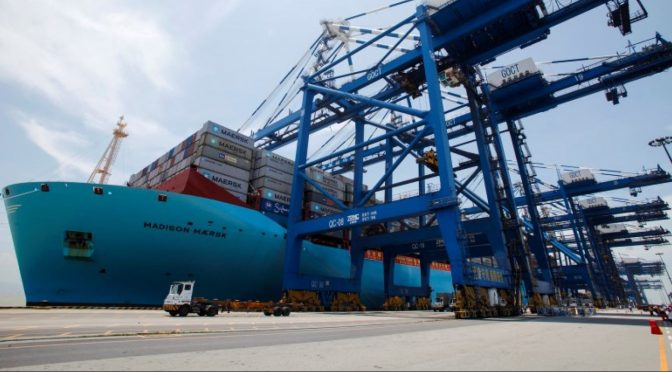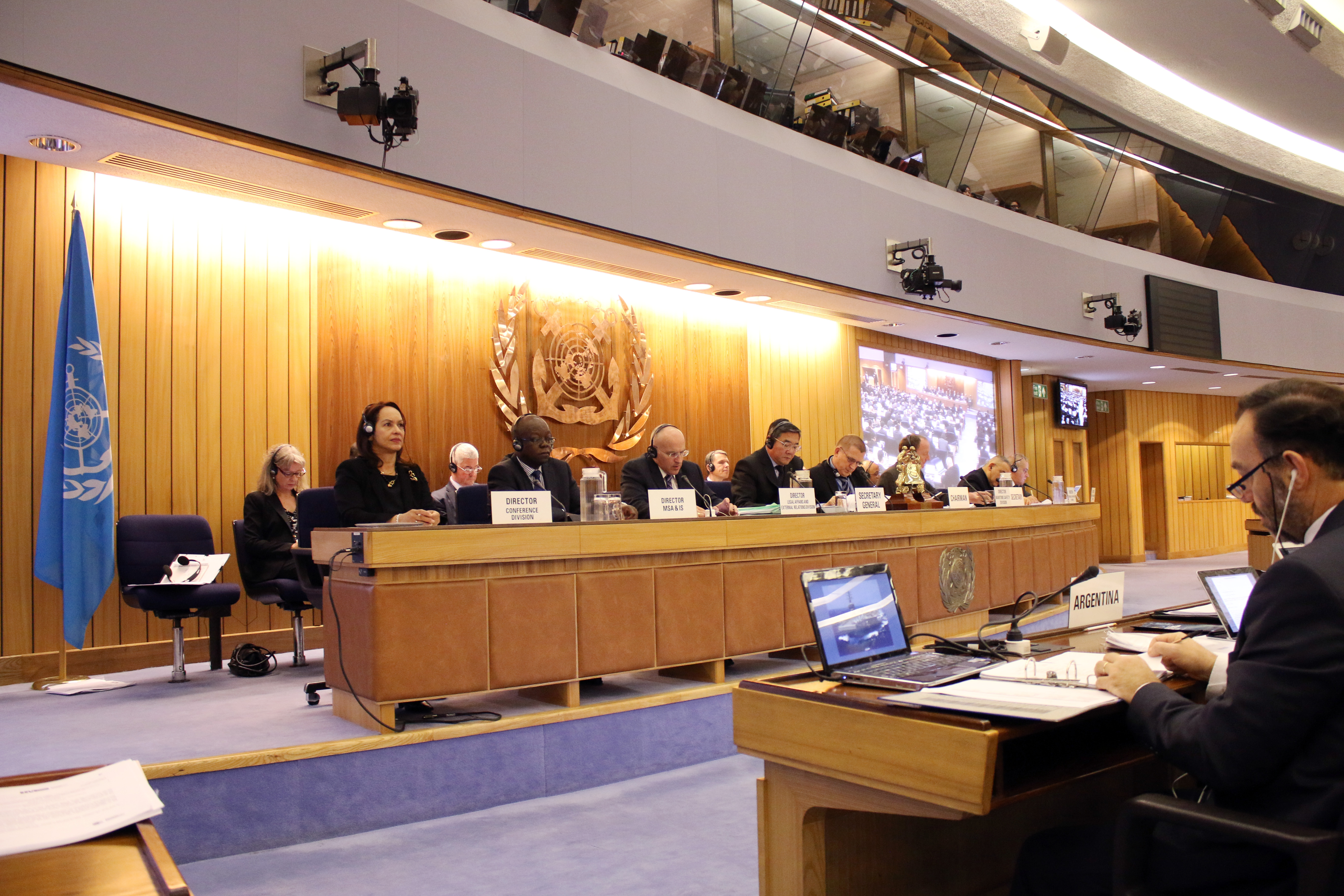By Conor M. Kennedy and Andrew S. Erickson
Part I and II of this conclusion to our series on Hainan’s maritime militia discussed the Hainan Provincial Military District (MD) leadership’s approach to constructing maritime militia forces in response to national militia guidelines and how they address challenges during construction efforts. This final installment in our series offers a glimpse into what the Hainan MD’s efforts have yielded in force scale. It also examines the incentivizes motivating the builders of this force, such as political drivers and pressures confronting local officials. The conclusion also outlines issues meriting further observation and analysis, such as the significance of the Sansha Maritime Militia force for China’s third sea force more broadly, and the degree to which Chinese officials frame related efforts as part of a “People’s War.”
Although this series has discussed in depth four key locations for maritime militia development, they are part of a far broader effort by the entire Hainan MD. The maritime militia units of Sanya, Danzhou, Tanmen, and Sansha should not be seen in isolation, but rather as elements of the Hainan MD militia force system. Directed by national militia construction guidelines and a highly publicized visit by paramount leader Xi Jinping to the Tanmen Maritime Militia, every other county in Hainan Province has established singular or multiple maritime militia units. These include districts of the provincial capital Haikou and many other directly administered and autonomous counties. Additional noteworthy maritime militia units are located in Lingshui County, Chengmai County, Changjiang Li Autonomous County, Wanning City, and Dongfang City. While our research to date has not revealed them to be on the same level of the four leading units in the totality of their documented capabilities or achievements, they nonetheless merit further examination. Dongfang and Wanning Cities’ maritime militia, for example, participated in defense of China’s HYSY-981 oil rig alongside the better-known Sanya and Tanmen maritime militia units.
Below is a map depicting all of the 31 maritime militia units under the Hainan MD jurisdiction identified as we conducted research for this series.
While local conditions produce considerable variety in unit scale and type, one can notionally estimate the total number of personnel and vessels in Hainan’s maritime militia force by assuming that the 31 units displayed are the rough median size of a militia company. Most maritime militia units, often referred to using tactical-level unit organization terms such as “fendui” (分队) or “company” (连), may comprise around 120 personnel and 10 vessels. This would yield a hypothetical total of 3,720 personnel and 310 vessels in Hainan’s maritime militia force. Such estimation is admittedly imprecise: Chinese organizational terms often lack both alignment with Western equivalents and consistency with regard to precise status and numerical size. As Kenneth Allen and Jana Allen explain, “Different Chinese and English dictionaries translate fendui (分队) as subunit, detachment, element, or battery…Although fendui refers specifically to battalions, companies, platoons, and sometimes squads, which together comprise the grassroots level (基层), a fendui can also refer to an ad hoc grouping of personnel organized for a particular function.” Moreover, characteristics specific to China’s maritime militia may accentuate organizational and numerical variation: some units lack vessels organic to the unit and rely on the requisitioning of civilian vessels for training and missions. Other detachments vary in size from 70 to over 300 personnel. Units also vary considerably in capability. Sansha City’s new maritime militia fleet, for instance, is vastly superior to the Chengmai County Maritime Militia Company.
The overall distribution of Hainan’s maritime militia force reflects the militia-building responsibility given to each locality as contained in the commonly invoked guidance that “provinces build battalions, cities build fendui, and counties build companies” (省建大队、市建分队、县建中队). While Hainan Province lacks a battalion-level unit and adherence to this formulation is less than exact, its various cities and counties have all established maritime militia fendui or companies. Required by the Hainan MD, every single Hainanese coastal city and county with a harbor has established its own maritime militia force.
Incentivizing Cadres
As documented throughout this series, China’s civilian and military leaders find strategic and operational advantages in the maritime militia, and have made use of these forces at sea. While key cities and counties with marine economies are sufficiently robust to support capable maritime militia forces, other localities with far less potential to form an elite maritime militia are nevertheless developing their own units. Other factors may also be driving this buildup. While this series has already surveyed the carefully-calibrated incentives available to maritime militia personnel for their services, it has not yet directly addressed the motivation of local officials involved in building the militia. This is ever-more critical: local civilian and military officials represent the key force in building the militia, which do not organize autonomously. This section will therefore consider the role of provincial politics and bureaucrats’ incentives in maritime militia building.
There is an obvious political dynamic involved in militia building, harking back to China’s radical past when revolutionary zeal constituted a criterion for cadres’ selection or promotion. To further their Party careers, local officials naturally embrace and support major political campaigns and policies. As China pursues regional predominance in maritime power militarily and economically, major national resources are being lavished on coastal provinces and their maritime forces. China is also actively working to boost the population’s maritime consciousness through a variety of measures, including by cultivating and publicly praising maritime militia leaders and their units. Hainan MD Commander Zhang Jian and Political Commissar Liu Xin wrote that leaders of People’s Armed Forces Departments (PAFD) should strive to be “rights protection commanders and political commissars,” and government leaders should serve as “rights protection secretaries or mayors.” Cadre evaluation, according to Zhang, rewards those who take the initiative in upholding China’s claimed maritime rights, suggesting increased opportunities for career advancement by local officials thus dedicated. Such grassroots forces are also intended to spread maritime awareness and consciousness among the masses, forming a component of national defense education on maritime affairs conducted by local People’s Liberation Army (PLA) Commands.
Success in maritime militia work can help local officials impress their superiors, potentially facilitating advancement. Numerous accolades are accorded governments, institutions, enterprises, units and individuals that contribute exceptionally to national defense efforts. Sansha City recently garnered national attention when it was designated a “National Double-Support Model City” in recognition of its exceptional assistance to the military, with which the Sansha Maritime Militia cooperates. The famous Tanmen Maritime Militia Company, which received a visit from President Xi Jinping in 2013 on the first anniversary of the Scarborough Shoal Incident, had previously earned numerous plaudits from the PLA for its persistent sea service. Having recently garnered multiple awards for its armed forces work, Lingshui County has made major progress in developing its maritime militia force. Reflecting such success, nine civilian armed forces cadres who worked with the militia have since risen to township deputy mayor and deputy party secretary positions, suggesting opportunities for career mobility through militia work.
Numerous reports celebrate the diligence of the Lingshui County PAFD Political Commissar Colonel Xing Jincheng on building up the maritime militia under his authority. After transferring to the Lingshui PAFD from his position as deputy political commissar of a PLA regiment, Colonel Xing expressed an unwillingness to relax in an easy “reserves” job. Dismissing suggestions that he rest after a long career, and ride out his final posting on Hainan’s scenic southern coast, Xing is lionized for instead devoting great energy to enforcing strict discipline in the PAFD staff and in building the Lingshui Maritime Militia. Extensive media coverage of Xing puts his efforts in the context of the latest PLA reforms; and the growing mission role of maritime rights protection, extending down to even grassroots PAFDs.
Other reports indicate that local government officials must fulfill their responsibilities in supporting national defense mobilization work as a key function of their position or else risk losing their jobs. For example, an article in the November 2016 issue of China’s Militia featuring Guangxi Autonomous Region’s efforts in this respect included an unattributed quote referencing military work by local civilian government and Party leaders: “[those] who don’t stress the importance of and cannot grasp armed forces work are incompetent and derelict in their duties.” The article then explains how Guangxi Party and government officials have increased their maritime militia force in response to the growing mission of rights protection in the South China Sea. China has raised Military-Civilian Fusion to the level of national strategy, as documented in the 2013 doctrinal volume Science of Military Strategy. As a result, officials in coastal provinces can be subject to performance metrics in construction of “maritime mobilization forces” (such as maritime militia) when considered for career advancement.

A Patriotic Employment Release Valve
The reduction in PLA Army personnel by 300,000 announced in September 2015 will likely exacerbate the growing number of PLA veterans who feel neglected by China’s government and society. Recent protests in Beijing by veterans groups highlight the fact that provincial MDs and governments are ill-prepared to deal with the newly demobilized troops that are currently or will soon be deprived of their previous employment. PAFDs are the front-line military departments that handle veteran’s affairs and work to reintegrate veterans into society. Responsible for organizing and managing local militia units, the thousands of county PAFDs across China can easily funnel these veterans into various militia units, affording these former soldiers a new chance to serve in leadership positions among the militia force. Indeed, news coverage of Lingshui County states more and more demobilized veterans are entering the maritime militia, becoming “the ‘vanguard’ in maritime rights protection.” The Hainan MD thus occupies advantageous terrain for converting demobilized PLA troops into a new grassroots force for furthering Chinese maritime claims in the South China Sea.
The Sansha Maritime Militia fleet exemplifies this new trend. Our installment on this unit documented how this new “state-run militia fishing fleet” functions primarily as a force for maritime rights protection. A break from the more traditional mode of maritime militia construction, as exemplified by the Tanmen Maritime Militia, this new fleet is manned by professional mariners, law enforcement, and PLA veterans who earn substantial salaries regardless of fishing catch performance. Chinese sources anticipated correctly that most of this fleet’s 84 vessels would be delivered by the end of 2016. In December 2015, the Guangzhou Taicheng Shipbuilding Industry Co. Ltd. featured one such vessel on its website, whose interior it furnished as a subcontractor following its construction by Xijiang Shipyard. The accompanying description stated that the vessel had a “weapons and equipment room” (武备库) and an “ammunition store” (弹药库). Open sources reveal this vessel, Qiongsanshayu 000212, to be part of the new fleet of Sansha Maritime Militia vessels delivered to the state-run Sansha City Fisheries Development Company, which operate under the guise of fishing. Details available in other open sources, some of which show the Sansha Maritime Militia training to load “light weapons” onto the deck of these new vessels, help confirm the intended roles and identities of this new militia fleet.
Openly available AIS data has identified all of the 84 Sansha Maritime Militia vessels operating in the South China Sea. Intermittent AIS transmissions (available via the website Marine Traffic) indicate that at least seven different Sansha Maritime Militia vessels were present at Scarborough Shoal at varying times, and 17 more vessels observed at Mischief Reef. While vessels may transmit AIS signals when operating singularly or in small groups, maritime militia vessels most likely move in larger groups: the Sansha Maritime Militia fleet comprises six companies, which generally operate as units. Openly available satellite imagery (e.g., from Google) also shows such vessel groups moored at Mischief and Subi reefs. In September 2016, the Philippine Ministry of Defense released photos of Sansha’s maritime militia vessels at Scarborough Shoal. Despite Philippine statements in October 2016 that PRC ships had left the shoal, AIS data reveal that Sansha Maritime Militia and CCG vessels were present there as recently as February to mid-April 2017. As this report went to press, AIS data and satellite images confirmed the presence of Sansha Maritime Militia vessels at Scarborough Shoal, Fiery Cross Reef, Mischief Reef, and Subi Reef.
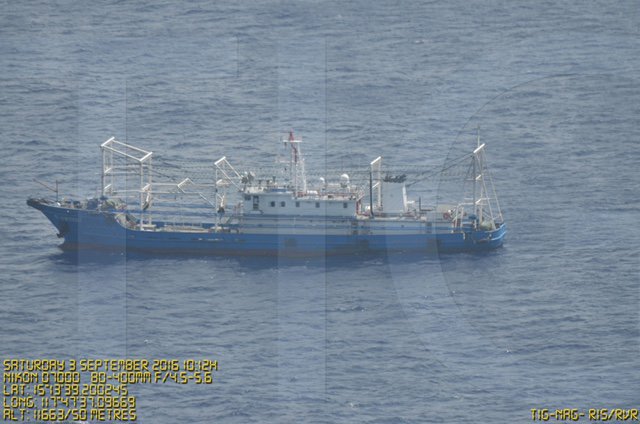
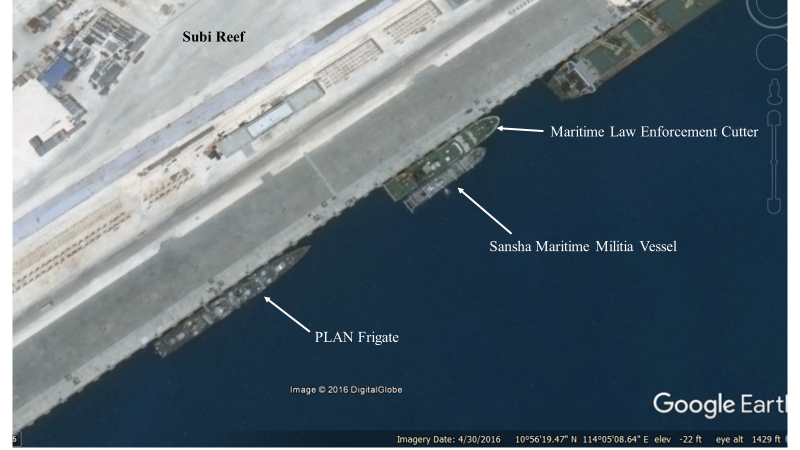
Sansha City Fisheries Development Company, the commercial name for its state-run militia fleet, was established quietly with little mention in the PRC press. This contrasted markedly with the often widespread fanfare and in-depth reporting on even minor economic achievements by Sansha City and Hainan’s marine economy. After all, local officials have every incentive to promote their advancement by trumpeting economic development, a key performance metric—unless instructed otherwise for information security reasons. The rapid construction of this militia fleet since its establishment in February 2015 raises the prospect of China replicating this new model of maritime militia building elsewhere, perhaps in the East China Sea. As part of any Chinese effort to prepare for East China Sea operations, one might imagine an analog to the Sansha Maritime Militia in another archipelagic municipality, such as Zhejiang Province’s Zhoushan City. It is clear that China has not abandoned the standard model of building the maritime militia out of existing commercial fishing and shipping fleets. However, the combined pressures of a commercial shipbuilding slump, large numbers of unemployed veterans reentering civil society, and benefits to political and military careers in local officials may make the Sansha Maritime Militia model attractive to other provinces.
With numerous projects and investments, Hainan Province is striving to become a global tourism destination. Major influxes of Chinese and foreign tourists toting smartphones and digital cameras make the Hainan MD’s task of ensuring security and secrecy in its military facilities increasingly arduous. Sanya City, for instance, is not only a popular vacation destination but also contains the Yulin Naval Base, a leading home for China’s secretive ballistic-missile submarine force. One of the militia’s missions is the security of important infrastructure and operations such as key ports or coastal patrols. Militia personnel also reportedly perform security functions to protect military facilities and national defense construction projects.
Finally, an additional security function of Hainan’s advanced maritime militia units is escorting China’s growing fleet of research vessels that perform hydrographic and geologic surveys. We introduced one example in our installment on Sanya’s maritime militia: the Sanya Fugang Fisheries Co. Ltd.’s 30-day escort mission for China National Offshore Oil Corporation’s April 2013 exploration in the Zhongjiannan basin south of Triton Island. This was the location of the HYSY-981 oil rig incident a year later. In another example, the Guangzhou Marine Geological Survey Office stated on its website in an undated article that “for years, our office has hired fishing vessels as escorts during every seismic and drilling operation for the protection of underwater cables and to ensure the smooth and safe progress of operations.” U.S. Naval War College professor Ryan Martinson has made public some of the most recent escort operations conducted by fishing vessels for PRC survey vessels. While the extent of the Hainan Maritime Militia’s continued involvement in these escort operations remains unclear, it appears to be a growing mission for China’s maritime militia overall and worthy of additional research.
Conclusion: People’s War Turns Seaward
This series has surveyed only a small portion of China’s total maritime militia force, the world’s largest. Part 1 examined national militia development guidelines and how they were translated by Hainan Province during its recent spate of maritime militia construction. Part 2 explored challenges confronting Hainan Province in its development of maritime militia forces and some of the solutions introduced to address them. Hainan Province is a key maritime frontier province, charged with administering all of Beijing’s expansive South China Sea claims. Yet Hainan as a province and military district does not build its maritime militia in isolation. It is, rather, one of many coastal provinces that raise such forces. In fact, other more economically and technologically advanced provinces—such as Guangdong and Zhejiang—possess greater socioeconomic bases on which to develop larger-scale, more technically sophisticated maritime militia units. Provinces construct militia forces in response to national militia guidelines under a dual-responsibility system between government/Party and PLA leaders. The resulting maritime militia fleets are thus made available to operate alongside the PLA Navy (PLAN), China Coast Guard, as well as other provinces’ maritime militia forces. Case in point: China’s defense of its HYSY-981 oil rig in 2014. PLA senior colonel and Professor Jiao Zhili of the Nanjing Army Command College’s National Defense Mobilization Department described the event as mobilization for military struggle: “during the ‘981’ offshore platform’s struggle with Vietnam in the South China Sea, the emergency mobilization of militia from Hainan, Guangdong, and Guangxi to the front lines on the perimeter was a major strategic deterrent for Vietnam.” The mobilization orders for this event originated in the former Guangzhou Military Region, now the Southern Theater Command. While maritime militia units are raised and directed by individual provinces, they fulfill roles within a grander regional military structure.
These forces are often discussed by outside observers in reference to China’s gray zone operations, while Chinese authors often invoke the tradition of People’s War when discussing the militia. The study of these irregular maritime forces begs the question of whether we are witnessing a form of “Maritime People’s War.” In Chinese strategic thought, People’s War is regarded as the mixed use of regular and irregular forces in peacetime (and wartime if necessary) to overcome a superior adversary (or multiple adversaries) through the adroit use of various tactics, deceit, and protraction. The PLA continues to uphold the core concept of People’s War, adapting and evolving specific elements of the strategy to suit modern strategic and operational needs. China’s 2006 Defense White Paper, for instance, states that the PLAN is “exploring the strategy and tactics of maritime people’s war under modern conditions.” As current strategic considerations call for prioritizing the enhancement of China’s maritime defenses, the PLA is likely expanding the operational space of People’s War to cover Chinese maritime claims to the maximum extent feasible.
For China’s provinces, the MD system is described as the “practical application of people’s war thought in the military system” and an important channel through which civilian-military integration efforts are implemented. Hainan MD Commander Zhang Jian also describes the missions of the Hainan MD’s maritime militia in terms of a Maritime People’s War. He advocates “us[ing] maritime people’s war as a means to declare sovereignty, participate in development, cooperate with law enforcement, and support combat operations.” Zhang outlined how the maritime militia will conduct missions within joint military-law enforcement-civilian defense operations, essentially making combined use of the main forces of the PLA services and the local forces of the provinces. Such amalgamation is a defining feature of People’s War. The incidents this series has explored illustrate the multifarious tools that China utilizes in order to seize tactical advantages envisioned in traditional concepts of People’s War. Provinces and their local forces undoubtedly comprise the fundamental elements of People’s War, and remarks by Chinese officials like State Councilor and Defense Minister General Chang Wanquan’s in August 2016 suggest official endorsement of such strategies. This raises questions beyond the scope of this series that require further research, particularly in reconciling China’s continued national tradition of militia building with the realities of modern warfare. This topic is certainly not absent from debate in China, as analysts wrestle with the adaptation and evolution of People’s War to suit supporting roles for the PLA of today. As China adapts a time-honored concept to serve growing maritime security interests, the maritime militia is proving critical to its operationalization.
At the very least, this series demonstrates the widespread local mandate for maritime militia building in Chinese provinces such as Hainan. Maritime militia building is directed by official policy in China’s coastal provinces. Most coastal counties and cities raise and sustain their own maritime militia units according to the scale of their respective marine economies. While the Chinese government may not often admit openly and outwardly to using its maritime militia forces to support its objectives at sea, the voices of key stakeholders inside China and the central guidance passed down to the provinces reveal much about plans to construct and use these forces. Regardless of how these forces are characterized, provinces use them to protect China’s claimed maritime rights and interests and to support an increasingly blue-water-capable PLAN by dispatching greater numbers of militia personnel away from their shorelines to increase China’s strategic depth at sea.
Numerous PLA authorities, including Commander Zhang Jian, articulate the value the presence of fishing vessels has in all of waters claimed by China to demonstrate sovereignty and protect maritime rights and interests. Deputy Director Xu Kui of the National Defense University’s National Defense Mobilization Research Department explains how the maritime militia is a key force under China’s new “military strategic guideline” of preparing for maritime military struggle, and that it must “maintain a regular presence in disputed waters.” Echoing others, Xu cites the longstanding success of the Tanmen Maritime Militia in preserving Chinese presence in the Spratlys. The Tanmen Maritime Militia offers living testimony to how even a single township or county can impact the status quo in maritime East Asia. This consideration is not lost on China’s leaders, and Hainan’s leading maritime militia units represent prime examples of the diverse avenues of force that Chinese provinces can develop and contribute in the service of overall national maritime ambitions.
For all these reasons, Hainan’s maritime militia—both the bulk of its forces overall and the elite vanguard units probed deeply in this series—will remain a key component of China’s statecraft and security efforts the South China Sea: as a standing, front-line force, with its leading units celebrated as models for others to emulate.
Conor Kennedy is a research associate in the China Maritime Studies Institute at the U.S. Naval War College in Newport, Rhode Island. He received his MA at the Johns Hopkins University – Nanjing University Center for Chinese and American Studies.
Dr. Andrew S. Erickson is a Professor of Strategy in, and a core founding member of, the U.S. Naval War College’s China Maritime Studies Institute. He serves on the Naval War College Review’s Editorial Board. He is an Associate in Research at Harvard University’s John King Fairbank Center for Chinese Studies and an expert contributor to the Wall Street Journal’s China Real Time Report. In 2013, while deployed in the Pacific as a Regional Security Education Program scholar aboard USS Nimitz, he delivered twenty-five hours of presentations. Erickson is the author of Chinese Anti-Ship Ballistic Missile Development (Jamestown Foundation, 2013). He received his Ph.D. from Princeton University. Erickson blogs at www.andrewerickson.com and www.chinasignpost.com. The views expressed here are Erickson’s alone and do not represent the policies or estimates of the U.S. Navy or any other organization of the U.S. government.
Featured Image: February 2017: Head of the Lingshui County PAFD Colonel Xing Jincheng, in plain clothes, speaks to the maritime militia under his command (CCTV News).


